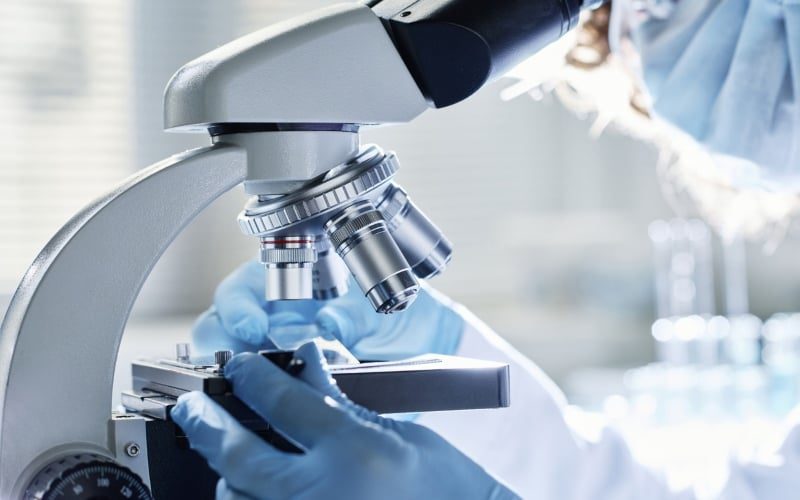
By Kelly Malcom
Food allergies most often bring to mind reactions like hives or an upset stomach. But a relatively recently recognized condition, known as eosinophilic esophagus or EOE, links allergic reactions to a distressing and sometimes dangerous inflammation of the tube connecting the mouth to the stomach.
A recent study from U-M offers more insight into the underlying causes of EOE.
EOE was discovered in the 90s and is often confused for a more familiar condition known as GERD, which can cause stomach acid to flow backwards into the esophagus. EOE and GERD share similar symptoms, but EOE is characterized by a thickening of the walls of the esophagus, which can cause food to get stuck when swallowing.
Sahiti Marella, Ph.D., working in the lab of Simon Hogan, Ph.D., the Askwith Research Professor of Food Allergy at the Mary H. Weiser Food Allergy Center and Professor of Pathology at U-M Medical School, was interested in the drivers behind the proliferation of cells of the esophageal lining.
Previous work in the field pointed to an immune protein, or cytokine, called IL-13 as the culprit behind inflammation and the remodeling of the lining of the esophagus leading to EOE.
But Marella wondered what exactly IL-13 was doing to lead to disease.
Using a publicly available database of biopsies from patients with EOE, the team generated RNA sequencing data of cells cultured from people with and without the condition to look for genetic differences that may underlie IL-13’s inflammatory effects.
They found 82 common differentially expressed genes that were enriched for STAT3 target genes.
STAT3 is a transcription factor responsible for the regulation of many cellular functions throughout the body.
Furthermore, 32 of the 82 genes were targets of STAT3, which has been implicated in cell proliferation with cancer.
Looking at the 32 STAT3 target genes, they identified one that was also associated with cell proliferation called SFRP1.
In cancer, SFRP1 protein is lost, leading to the out-of-control proliferation of cells.
However, the U-M team found that SFRP1 mRNA is increased in esophageal biopsies from patients with active EOE compared with healthy controls or patients in remission.
This fact, Marella explains, could be the reason that EOE, unlike GERD, does not progress to cancer.
Building on this work, Marella plans to further study SFRP1’s role in the proinflammatory and thickening of the esophageal lining.
This work was supported in part by the University of Michigan Orthopaedic Research Laboratories Histology Core and the University of Michigan Medical School Microscopy Core.
Paper cited: “IL-13-induced STAT3-dependent signaling networks regulate esophageal epithelial proliferation in eosinophilic esophagitis,” Journal of Allergy and Clinical Immunology. DOI: 10.1016/j.jaci.2023.07.021
—
Previously Published on michiganmedicine.org with Creative Commons License
***
You Might Also Like These From The Good Men Project
 Compliments Men Want to Hear More Often
Compliments Men Want to Hear More Often  Relationships Aren’t Easy, But They’re Worth It
Relationships Aren’t Easy, But They’re Worth It  The One Thing Men Want More Than Sex
The One Thing Men Want More Than Sex  ..A Man’s Kiss Tells You Everything
..A Man’s Kiss Tells You Everything Join The Good Men Project as a Premium Member today.
All Premium Members get to view The Good Men Project with NO ADS. A $50 annual membership gives you an all access pass. You can be a part of every call, group, class and community. A $25 annual membership gives you access to one class, one Social Interest group and our online communities. A $12 annual membership gives you access to our Friday calls with the publisher, our online community.
Register New Account
Log in if you wish to renew an existing subscription.
Username
First Name
Last Name
Password
Password Again
Choose your subscription level
- Yearly - $50.00 - 1 Year
- Monthly - $6.99 - 1 Month
Credit / Debit Card PayPal Choose Your Payment Method
Auto Renew
Subscribe to The Good Men Project Daily Newsletter By completing this registration form, you are also agreeing to our Terms of Service which can be found here.Need more info? A complete list of benefits is here.
—
Photo: iStock
The post More Clues Revealed About the Causes of an Allergic Inflammation of the Esophagus appeared first on The Good Men Project.
Original Article










